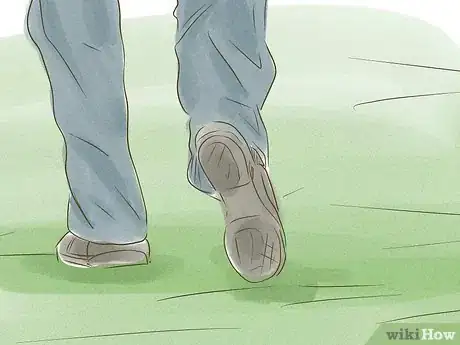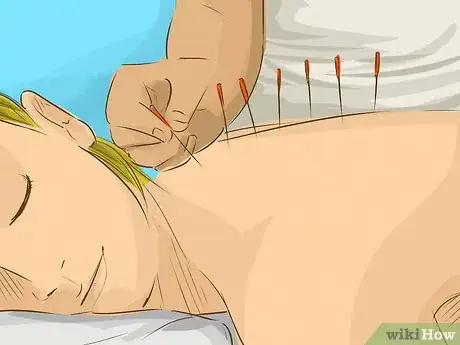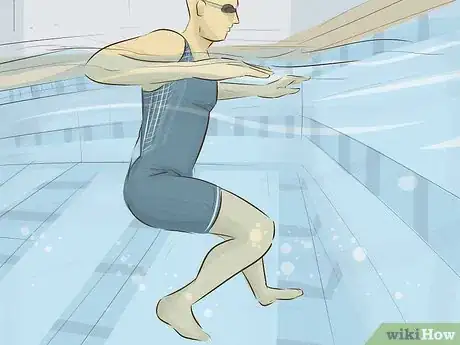This article was co-authored by Joshua Grahlman, PT, DPT, FAFS. Dr. Joshua Grahlman, PT, DPT, FAFS, is the Founder and Chief Athlete Mechanic of Clutch PT + Performance, a private physical therapy clinic specializing in sports and orthopedics in New York City. With more than a decade of experience, Dr. Grahlman specializes in treating acute and chronic pain and injuries, sports performance optimization and post-operative rehabilitation. Dr. Grahlman earned his Doctorate of Physical Therapy (DPT) from Columbia University College of Physicians and Surgeons. He is one of just a few DPTs in New York City recognized as a Fellow in Applied Functional Science through the Gray Institute for Functional Transformation (GIFT). He is certified in Active Release Technique and Spinal Manipulation and is a TRX Suspension Training Specialist. Dr. Grahlman has spent his career treating athletes of all levels, from Ironman Champions and Olympians to marathoner moms. He consults for Triathlete, Men’s Health, My Fitness Pal and CBS News.
There are 18 references cited in this article, which can be found at the bottom of the page.
wikiHow marks an article as reader-approved once it receives enough positive feedback. In this case, 80% of readers who voted found the article helpful, earning it our reader-approved status.
This article has been viewed 374,845 times.
If you have swollen feet, you are not alone. Many people suffer from this condition, as it is a side effect of a number of medications and a symptom of many diseases. Therefore, if you have swollen feet, you should always be checked out by a doctor to determine the underlying cause. Nonetheless, you can make some changes to help reduce the severity of this condition.
Steps
Exercising and Resting Swollen Feet
-
1
-
2Take breaks. If you have a job where you must sit down for long periods of time, try to take breaks.[4] Get up every hour or so and walk around for a few minutes to get you blood pumping again. If you can’t get up, try doing some calf raises while sitting. Simply raise your heel and then lower it. Repeat this 10 times on each side.Advertisement
-
3Exercise every day. Exercising a little bit every day can help with swelling over time. For instance, try a walk after work every day. Alternatively, try incorporating a short bicycle ride every day in your routine.[5]
-
4Elevate your feet while resting. If you have a job where you sit most of the time, try to raise your feet up when you're sitting. By raising your feet above your heart, you're making your circulatory system work less hard to get the fluid up from your feet.[6]
- You don't have to have your feet elevated all day; just try to do it a couple of times a day. It may also help to have them elevated at night.
- If you have a desk job, ask your boss if it's appropriate to use a footstool at work.
- When elevating your feet, try not to cross your ankles or legs because that can put too much pressure on veins and restrict blood flow.
- When you elevate your feet, you're allowing gravity to help pull the swelling back in toward your body from your feet, so it can be reabsorbed into your lymph system.[7]
Making Lifestyle Changes
-
1Consume less dietary salt. If your diet is high in salt, it can contribute to swollen feet.[8] When you have too much salt, your body holds on to it, and in the process, also holds on to extra water, which can contribute to swelling.[9]
- In addition to the feet and ankles, your face and hands can also be puffy when eating a high-salt diet.
- Most processed foods (such as canned foods, frozen dinners, and salad dressings) are high in salt (sodium), so buy more fresh produce and meats from the grocery store and prepare them at home.[10]
- Store-bought products especially high in sodium include canned tomato and pasta sauces, soups, salsas, crackers, pickled veggies, lunch meat, and even cheeses. Check the label for the sodium content, and look for words like "low-sodium."[11] Even some fresh meats may be injected with salt and water.[12]
- Compare brands. Some brands will have less salt than others.[13]
- Your dietary sodium intake should be between 1,500 mg and 2,300 mg per day, depending on your gender and size.[14]
-
2Try to lose weight. Because weight can contribute to swelling, losing weight can help with swelling in your legs.[15] Try changing up your diet so you're eating more fruits and vegetables, lean meats, and whole grains, while slowing down on empty sugar calories. Incorporating a diet change with an increase in exercise can speed up the process.
-
3Avoid tight clothing on your thighs. When you have tight clothing around your thighs, it can limit circulation. Therefore, try to skip garters and other types of clothing that may restrict circulation.[16]
-
4Wear compression stockings. Wearing compression stockings can help decrease the fluid in your legs. Basically, it wraps around your leg, giving it the support it needs to keep fluid from pooling there.[17]
- You can find compression stockings online, at medical supply stores, and sometimes at your pharmacy.
-
5Get a different pair of shoes. If you're having trouble with swollen feet, you probably need a new pair of shoes to help with your treatment. Change to shoes that grip your heel, provide enough room to wiggle your toes, and have good arch support. The best time to try on shoes is in the afternoon, as your feet will be the most swollen then; that way, you can get shoes that fit you all the time, even when your feet swell more.[18]
- If your shoes are too tight, they can cut down on blood flow, as well as cause other problems with your feet, such as light sprains.
-
6Try a self-massage. Work on you legs by rubbing up from your feet towards the top of you body; you just need to work on your ankles and calves. Don't rub so hard that you cause yourself pain, but do it firmly. This type of massage can help reduce fluid near your ankles and feet.[19]
Seeking Medical Treatment
-
1Schedule an appointment. If home remedies and natural treatments aren't as effective at reducing the swelling in your legs as you'd hoped, then schedule an appointment with your family physician. Your doctor will examine your feet and legs and see if the swelling is caused by anything more serious.[20]
-
2Discuss your current medications. Certain medications can contribute to swollen feet. For instance, antidepressants, medications for high blood pressure, and hormone-based pills (such as birth control) can all have this side effect. Steroids can also cause this problem.[21]
-
3Understand the causes of swollen feet. In many cases, edema is caused by a minor problem. However, sometimes it can indicate a more serious health condition. Discuss the possibilities with your doctor.[22]
- For instance, for milder forms, pregnancy or PMS (premenstrual syndrome) might be the cause. Also, you may not be moving enough, or you may be eating too much salty food.
- More serious causes include cirrhosis, kidney disease, kidney damage, congestive heart failure, chronic venous insufficiency, or a damaged lymphatic system.
-
4Seek medical attention if you begin to feel shortness of breath, have chest pain, having swelling in the legs and abdomen, and/or your swollen foot is red or warm to the touch.
-
5Know what tests to expect. Your doctor will talk with you about the problems you've been having with your legs. She may also ask about any other symptoms you may be having. In addition, she may run some diagnostic tests to better understand the underlying condition.
- For instance, she may run blood tests or urinalysis, take X-rays, do an Doppler ultrasound exam of your legs, or run an ECG.[23]
-
6Ask about treatment. Generally, your treatment will help with the underlying problem, not a drug specifically targeted at the swollen feet. However, sometimes diuretics can help bring the fluid down in your feet.[24]
-
7Consider acupuncture. Acupuncture is an ancient healing technique that originated primarily in China. It involves placing fine needles into specific energy points within the skin and muscle in an effort to reduce pain and swelling and stimulate healing. Acupuncture for swelling in the feet is not a commonly recommended treatment by mainstream medical professionals. However, if you've tried other treatments without success, then it's worth trying due to its relative safety and well-documented success with many other diseases and conditions.
- Acupuncture is now practiced by many more mainstream health professionals; whoever you pick should be certified by the National Certification Commission for Acupuncture and Oriental Medicine; people with this certification have passed an exam.
Getting Relief for Swollen Feet Due to Pregnancy
-
1Try pool walking. Though not enough research has been done on this phenomenon, many pregnant have had good luck with water walking. It's likely that the pressure of the pool water on your feet helps reduce fluid in your legs, lowering swelling.[25]
-
2Go to sleep on your left side. A large vein, called the inferior vena cava, runs from the bottom part of your body up to your heart. By sleeping on your left side, you're not applying as much pressure to it, and so it can properly circulate fluid.[26]
-
3Try cold compresses. Sometimes cold compresses can help with swollen ankles while you're pregnant. Use an ice pack wrapped in a towel or even just a washcloth dipped in cold water. Don't leave it on for more than 20 minutes.[27]
-
4Use the same techniques as you normally would for swollen feet. That is, you can use compression stockings while you're pregnant to help control the swelling. Additionally, don't stand up too long; sitting with your feet above your chest is a better option while pregnant.
- Don't forget to include light exercising in your routine while your pregnant. You can try a daily walk to get your blood flowing.
Expert Q&A
-
QuestionHow do I get rid of swelling in my feet?
 Joshua Grahlman, PT, DPT, FAFSDr. Joshua Grahlman, PT, DPT, FAFS, is the Founder and Chief Athlete Mechanic of Clutch PT + Performance, a private physical therapy clinic specializing in sports and orthopedics in New York City. With more than a decade of experience, Dr. Grahlman specializes in treating acute and chronic pain and injuries, sports performance optimization and post-operative rehabilitation. Dr. Grahlman earned his Doctorate of Physical Therapy (DPT) from Columbia University College of Physicians and Surgeons. He is one of just a few DPTs in New York City recognized as a Fellow in Applied Functional Science through the Gray Institute for Functional Transformation (GIFT). He is certified in Active Release Technique and Spinal Manipulation and is a TRX Suspension Training Specialist. Dr. Grahlman has spent his career treating athletes of all levels, from Ironman Champions and Olympians to marathoner moms. He consults for Triathlete, Men’s Health, My Fitness Pal and CBS News.
Joshua Grahlman, PT, DPT, FAFSDr. Joshua Grahlman, PT, DPT, FAFS, is the Founder and Chief Athlete Mechanic of Clutch PT + Performance, a private physical therapy clinic specializing in sports and orthopedics in New York City. With more than a decade of experience, Dr. Grahlman specializes in treating acute and chronic pain and injuries, sports performance optimization and post-operative rehabilitation. Dr. Grahlman earned his Doctorate of Physical Therapy (DPT) from Columbia University College of Physicians and Surgeons. He is one of just a few DPTs in New York City recognized as a Fellow in Applied Functional Science through the Gray Institute for Functional Transformation (GIFT). He is certified in Active Release Technique and Spinal Manipulation and is a TRX Suspension Training Specialist. Dr. Grahlman has spent his career treating athletes of all levels, from Ironman Champions and Olympians to marathoner moms. He consults for Triathlete, Men’s Health, My Fitness Pal and CBS News.
Physical Therapist & Entrepreneur The first thing to do would be to increase your walking, do strength training, heel raises, and stuff like that. That will help get the muscle pump going in your legs to help return that fluid back up. If that's not working, elevate your feet above your heart so gravity can pull the swelling back up to your body.
The first thing to do would be to increase your walking, do strength training, heel raises, and stuff like that. That will help get the muscle pump going in your legs to help return that fluid back up. If that's not working, elevate your feet above your heart so gravity can pull the swelling back up to your body.
References
- ↑ http://cchealth.org/column/healthy_outlook_jul11_2004.php
- ↑ Joshua Grahlman, PT, DPT, FAFS. Physical Therapist & Entrepreneur. Expert Interview. 8 September 2020.
- ↑ Joshua Grahlman, PT, DPT, FAFS. Physical Therapist & Entrepreneur. Expert Interview. 8 September 2020.
- ↑ https://www.nlm.nih.gov/medlineplus/ency/article/003104.htm
- ↑ https://health.clevelandclinic.org/6-best-ways-relieve-swollen-feet-ankles-home/
- ↑ https://health.clevelandclinic.org/6-best-ways-relieve-swollen-feet-ankles-home/
- ↑ Joshua Grahlman, PT, DPT, FAFS. Physical Therapist & Entrepreneur. Expert Interview. 8 September 2020.
- ↑ https://health.clevelandclinic.org/6-best-ways-relieve-swollen-feet-ankles-home/
- ↑ http://patient.info/health/idiopathic-oedema
- ↑ https://www.kidney.org/news/ekidney/june10/Salt_june10
- ↑ https://www.kidney.org/news/ekidney/june10/Salt_june10
- ↑ http://www.cdc.gov/salt/food.htm
- ↑ https://www.kidney.org/news/ekidney/june10/Salt_june10
- ↑ http://www.cdc.gov/salt/food.htm
- ↑ https://www.nlm.nih.gov/medlineplus/ency/article/003104.htm
- ↑ https://www.nlm.nih.gov/medlineplus/ency/article/003104.htm
- ↑ https://health.clevelandclinic.org/6-best-ways-relieve-swollen-feet-ankles-home/
- ↑ http://www.footsmart.com/health-resource-center/leg/swollen-ankles
- ↑ https://health.clevelandclinic.org/6-best-ways-relieve-swollen-feet-ankles-home/
- ↑ https://www.health.harvard.edu/diseases-and-conditions/whats-causing-those-swollen-feet
- ↑ https://www.medicalnewstoday.com/articles/323265#medication
- ↑ https://www.health.harvard.edu/diseases-and-conditions/whats-causing-those-swollen-feet
- ↑ https://www.nlm.nih.gov/medlineplus/ency/article/003104.htm
- ↑ https://www.nlm.nih.gov/medlineplus/ency/article/003104.htm
- ↑ https://flo.health/pregnancy/pregnancy-health/pains-and-discomforts/how-to-reduce-swelling-during-pregnancy
- ↑ https://www.sleepfoundation.org/sleeping-positions/side-sleeping
- ↑ https://www.uofmhealth.org/health-library/tw4354spec
- ↑ http://www.emedicinehealth.com/cirrhosis/page3_em.htm
About This Article
To quickly and easily reduce swelling in your feet, get your circulation going by walking instead of standing, which can allow fluid to pool in the legs. To get your blood pumping after sitting for extended periods, take walk breaks or try doing 10 heel raises on each leg. Additionally, you can massage your legs from the feet up to break up fluid buildup. If your swollen feet are a result of pregnancy, in addition to the above recommendations try sleeping on your left side. A large vein runs from your lower body to your heart and can become compressed when you sleep on your right side. To learn more from our Chiropractor co-author, like when to seek medical treatments, keep reading the article!












-Step-3-Version-3.webp)






































































Medical Disclaimer
The content of this article is not intended to be a substitute for professional medical advice, examination, diagnosis, or treatment. You should always contact your doctor or other qualified healthcare professional before starting, changing, or stopping any kind of health treatment.
Read More...